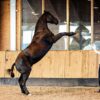You have to be very honest with yourself at this point.
And you need to check very thoroughly that you have the background for training that is free from fear, very calm and based on communication and autonomy. You cannot fool yourself at this point. If you have any problems come back to square one and work on CALMNESS. You will be amazed how many problems that people are trying to solve with the horses are based on fear and lack of calmness. This is something that we will do all the time: in case of any problems, we are coming back to the beginning and checking back everything.
This may sound to you a little bit “slow”, but you will see that in practice this approach makes training very fast and effective.
At this point in training we should have:
- a calm horse and a calm you,
- communicating with each other,
- giving autonomy to each other and at the same time with respect to the boundaries that make the training safe for both of you.
From this point, we can work on Engagement.
By engagement I mean that our horse is really consciously trying to do what we are asking him to do. Engagement is not possible without autonomy simply because it is a choice that someone makes. When there is no choice, there is no engagement. This is another thing I would like you to think about: we will work on horse’s thinking, not movements.
Engagement also needs communication because you need a way to tell your horse what the exercise is, what the criteria within that exercise are and to give feedback when the exercise is done well. From my experience, horses are very ambitious and they really WANT to do what you propose to them. But to want something, I need to have a choice. When there is no choice, I don’t want anything. I want it finished and I want to come back to my safe place. And that is why there is no engagement without the true autonomy.
When you challenge your horse with some exercise you need to remember that the horses are very ambitious and they really try hard and want to do things well. That means that if they don’t understand what you want from them they are frustrated and vulnerable to failures. And they will show you this, you have to listen.
Also, you need to remember that really trying to do something new is very demanding and you cannot do this for a very long time. You cannot train your horse this way for an hour. Sometimes 10 minutes will be too long. Again, your horse will tell you this. And to keep the situation in state of mutual respect and to keep your horse feeling safe you have to listen.
To keep your horse engaged in longer perspective you need to finish your training when he is still 100% engaged. This does not mean that you have to end on a success. It means to end the training when your horse still wants to try.
To check if this is true in your life you should observe your horse’s willingness to prepare him for training, going to the training arena and staying with you in the training arena. A little bit exaggerating this situation: your horse should run by himself to train with you.
Engagement is very important if you want to do any kind of sport with your horse. This is something that will allow us to do any difficult exercises in the future. But this needs another change in your mind. You cannot force your horse to do anything. You can simply propose something and give feedback when the exercise is done correctly.
You will be amazed to see that the Old Masters of Horsemanship were very wise and all the Haute Ecole exercises are designed this way that so that horses really LIKE them, as they make them feel proud and horses want to present themselves in the most beautiful way. But the trick is not to force your horse to do these exercises like piaffer or passage, but to prepare your horses to do these exercises by themselves. These exercises are not meant to train the horses, they are meant to allow the horse to show his beauty and strength.
But this is not possible without engagement. No horse will do energetic piaffer in a beautiful and regular way when he is not really engaged in this movement. To make it happen you need a calm horse understanding what you want from him, committed by himself to this exercise.
So now you see why autonomy is so important.
Without autonomy your horse cannot make the decision to try better piaffer. You also need to remember that your horse REALLY LIKES to do this kind of exercises and when they have autonomy they will do this by themselves and this is good. So we never punish the horse when he is doing something out of his free will. This is another thing I want you to think about and change your attitude towards it.
This will be the first step to build real cooperation.


